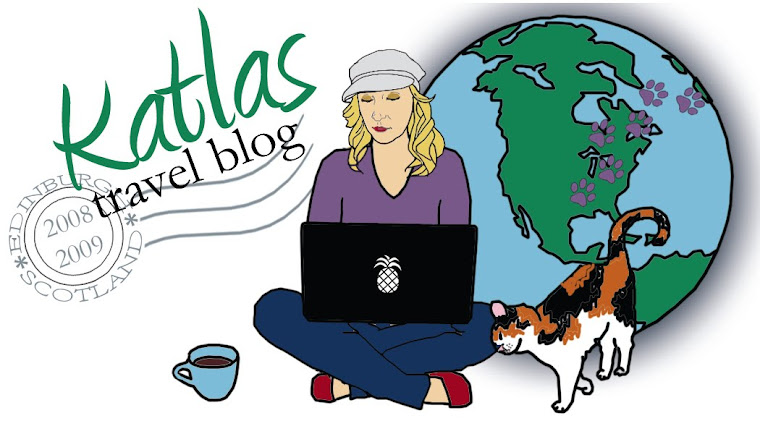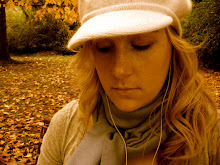
Those are my kind of sheep!
We jumped on another ferry out to the Isle of Staffa, which is home to Fingal's Cave. On Staffa, there were volcanic rock, or basalt, formations in tall columns. The same basalt appears on The Giant's Causeway in Northern Ireland. Both places were named for the legend of the giant Fionn Mac Cumhaill (Finn McCool). The legend said that the Irish giant, Finn, was building a causeway from Ireland to Scotland, to fight his Scottish counterpart, Benandonner. But Finn fell asleep before he got to Scotland. When he didn't show, Ben went in search of him. Finn's wife put a blanket over her husband and disguised him as their baby son. When Ben saw the sheer size of their "son", he fled in fear of how giant Finn must be - ripping up the causeway as he went. So all that remains now is a bit in Ireland and a bit in Scotland. Still another version of the story said that Finn asked his wife to dress him up as their son when they had Ben over for dinner. She fed her "son" actual tender beef, but fed Ben a rock cut to look like steak. When Ben had trouble biting into the rock and saw how easily the "baby" bit into the meat, that's why he ran and ripped up the bridge between the two countries. I swear that one of the BG's gave a picture book of this tale to either Brendan or Jack, because I remember reading it to them when babysitting. I think it was Bridget, possibly because Finn's wife's name was Bridget and she wrote a little note on the inside cover about it. Kara, help me out here...

Fingle's Cave
Despite the legends, there were no giants in sight. Our ferry boat dropped us on a small slab of concrete and motored away to drop anchor in the middle of the sea - leaving us to cling to the cliffside. Literally, we had to cling to the sides of Staffa and make our way cautiously around to the mouth of the cave. There was a huge traffic jam from people were trying to go both directions on such a narrow and slippery path. I took a picture of the jam... and then ate it. I don't know exactly how I fell while standing completely still, but I just went straight down. You know how in cartoons, when their legs fly up and they pause horizontally in the air and then just drop straight down like a plank. That was me. Luckily, I didn't hurt myself, or anyone else, or fall into the water... that would have been sooooooo freezing. I don't even think my parents knew that I fell. I didn't want to worry them at the time. I was so impressed that they were climbing around with me that I didn't want to say anything to discourage them. Plus, we all know that I'm clumsy. There was nothing I could have done to prevent it. My falling was inevitable.
Traffic jam on Staffa
Another fun fact about Staffa is that composer Felix Mendelssohn visited the isle in 1829 and wrote Die Hebriden (Hebrides Overture Opus 26, commonly known as Fingal's Cave overture). He was inspired by the weird echoes that can be heard within the cave.
It wasn't enough for us to climb around the sides of the isle, we also had to climb to the top. There was a set of rusty, rickety, old stairs for us to use. They were even more fun than the "non-slip" painted basalt stepping stones around the base of Staffa. Supposedly, there is a gathering of puffins somewhere on Staffa. Sadly, we could not find the puffins. No pear trees either... but we weren't really expecting to see those.

Staffa from the top
Thankfully, our boat came back for us, and then ferried us over to the Isle of Iona. Which, with it's beautiful white sandy beaches and crystal clear blue/green waters, looked a hell of a lot like Rhodes, Greece! Except it was probably 30 degrees colder here in Scotland. Iona was famous for its Abbey. In the Middle Ages, St. Columba landed on Iona and built the Abbey. Just outside the Abbey was the Chapel of St. Oran and the graveyard where 48 Scottish Kings were buried (of Scottish, Irish, and Norwegian backgrounds). It is rumored that MacBeth was buried there as well. However, we have no idea where, because a while back, the Ionians decided they would bring the Kings' tombstones indoors to preserve them... but they forgot to leave post-its behind saying whose graves are whose. Silly Ionians.
There were more lambs on Iona. I wrote a song about this one:
Katharine had a little lamb,
little lamb,
little lamb,
Katharine had a little lamb,
And then security confiscated it at the border...
Then it was a ferry back to Mull, a bus ride across Mull back to Craignure, a ferry back to Oban, and a car ride back to our castle. (I just love saying "our castle"). The Campbells knew that we were out all day, exhausted form trekking around in the rain, so they lit a fire for us in the Cozy Room. It was waiting for us when we got back. The Cozy Room probably has a proper castley name like The East Wing, but I call it the Cozy Room, because it was so small, and had comfy chairs and sofas, a wonderfully warm fireplace, and a TV where my Mom and I watched When Harry Met Sally until it was time for bed. Oh Barcaldine Castle, I miss you.
The Cozy Room









2 comments:
Haha I have no idea what you're talking about with that picture book. But it's entirely possible that happened. You'll have to ask Aunt Sue at the next family event.
Its called the Laird's Parlor.
Post a Comment